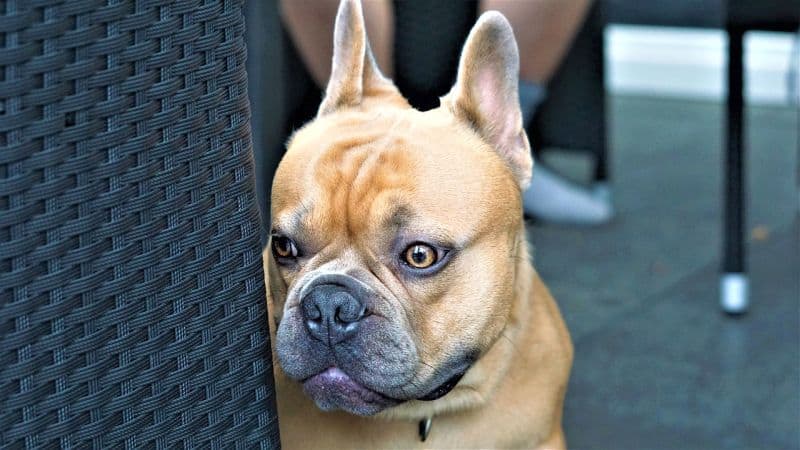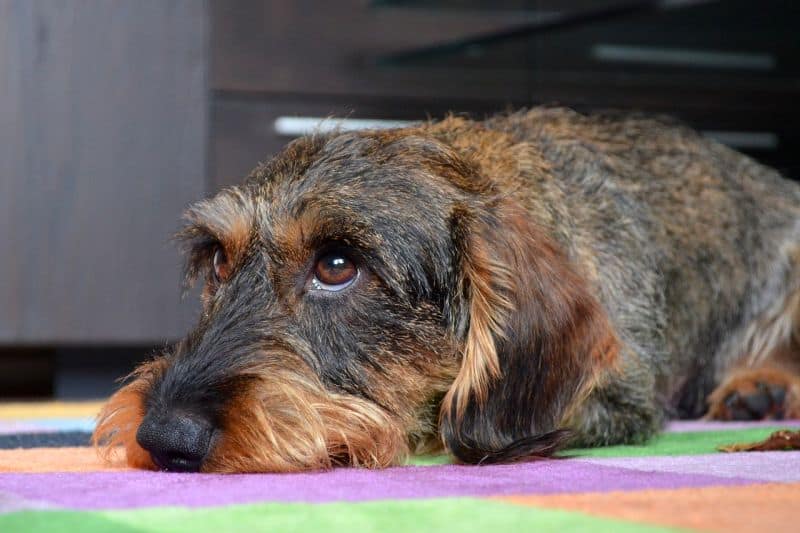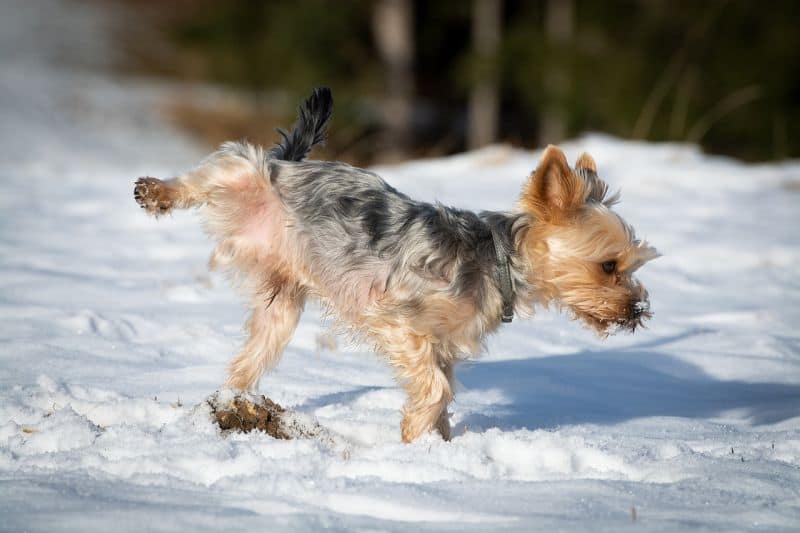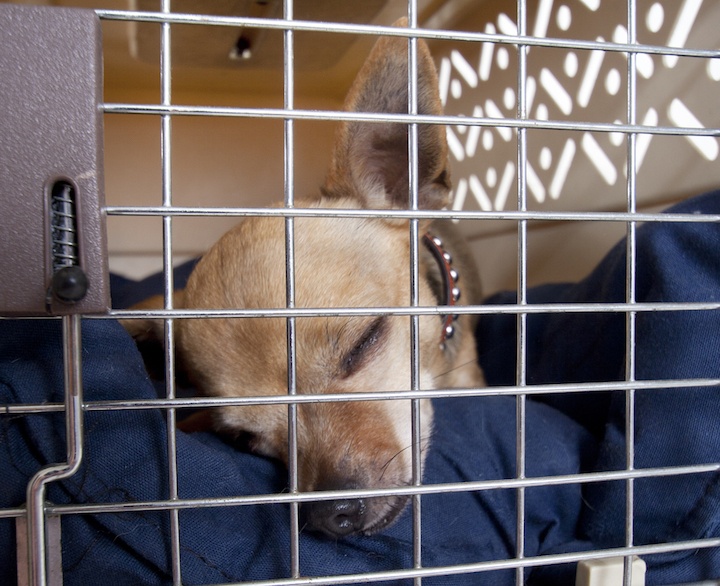How To Get A Dog To Pee Outside
You've read the books and watched the tutorials, but your pup still prefers to pee on the carpet in the corner of the room.
It's smelly, messy, and downright frustrating. What can you do to teach her the rules – to pee and poo outside the house?
Below we will explore some of the reasons why soiling indoors might be a harder problem for some dogs to overcome than others!
- There are a variety of reasons that a dog may not want to relieve herself outdoors, ranging from health problems to poor house-training.
- Your first step in correcting the issue is identifying the reason your dog doesn't want to go outdoors to pee or poop.
- Once you've identified the reason, you can implement the proper training strategy. For example, if pee pads are confusing your dog, you may want to get rid of them and focus on training her to go outdoors.
Reasons Why a Dog Might Not Pee Outside
There are several reasons your dog may prefer the carpet to the grass when doing her business, and it's important to figure this reason out, so you can address the problem head-on.
You might find that your dog's pee-pee problem is due to one or more of the following:
Health Problems
If peeing on the carpet or elsewhere in the house is a new problem, it's wise to first rule out any underlying medical issues.
Here are some more common medical ailments that might be causing indoor elimination:
- Urinary Tract Infections (UTIs) — A UTI can cause your pooch to feel as though she needs to urinate urgently and frequently. Having this diagnosed by your vet means that you can easily have her treated and it may just solve the problem altogether. If your dog is prone to UTI's, your vet might also suggest a specific diet to help with prevention.
- Arthritis — This is one that often goes undetected. It's hard to notice the slow progression of arthritis and similar changes when we see our dogs every day. And dogs are pretty stoic. But if she's feeling pain, the stairs to the yard might be too daunting. The colder temperatures or damp weather might also affect how she is feeling, and you may notice an upswing of indoor urination in the wetter or colder months.
- Incontinence —This can be normal when it happens to older dogs, but did you know that it can also affect younger dogs as well? Particularly females. It can also happen after she has her spay operation due to an imbalance of hormones. Make sure to read up on the pros and cons of spaying and neutering a dog for more details.
- Diabetes or Kidney Problems — Diabetes or conditions involving kidney function can cause an increase in water intake. This can in turn cause urgent and more frequent need to urinate.
- Cognitive Dysfunction (Doggie Dementia) — Whether or not there are other underlying health issues, dementia and other cognitive problems could potentially cause an increase in water intake as well. For example, my old dog who suffered from cognitive dysfunction seemed to drink and then go back for more immediately after. It could be her brain not properly relaying that information or it could be confusion or simply forgetting. If you have an older dog who is peeing in the house after being outside, it could certainly be the result of doggie dementia.
Fear or Anxiety About Something Outside
It is possible that your pup might be worried or frightened to go outside, and that's why he won't pee outdoors.
Perhaps she had a bad experience, such as fireworks suddenly going off while she was out for a potty break.
Or, she might have a more general fear of things in her environment, such as sights, sounds, and/or smells that are stressing her. Other dogs (especially rescue pooches) may be afraid of the leash that they won't pee while on a leash because they are so freaked out and have never been walked on a leash before!
Some dogs are absolutely overwhelmed or super anxious when outdoors. One common sign of an anxious outdoors pooch is a dog that will constantly stop during walks and refuse to continue walking.

Poor House-Training
The older a dog gets, the more her behaviors become habits. If your new rescue is struggling to grasp the peeing outdoor concept, it could be because she has spent most of her life thinking that peeing indoors was proper. Or perhaps her potty training was incomplete.
Additionally, people who use pee pads for their puppy in the beginning or through certain seasons may find that their dog has trouble making the switch once it's time to start going outside. Or when using pee pad intermittently, it can become confusing for your dog.
When potty training, consistency is key. Puppies need to urinate often, so it is important to provide plenty of opportunities for your pooch to relieve herself.
A good rule of thumb is they can hold it for one hour for every month they are in age plus one. So, a 3-month-old puppy is likely only able to hold her bladder for a maximum of 4 hours.
Marking
Marking occurs when dogs pee for social reasons, rather than in order to empty their bladder. Marking is most common in male dogs, but some females can also scent mark. It could be that your dog is peeing outdoors, but also indoors.
The behavior can sometimes be reduced or eliminated with neutering or spaying. However, it can also become a habit.

Are Some Breeds Trickier to House Train than Others?
All breeds are capable of learning to pee and poop outside, but there are a few reasons why some breeds are seemingly harder to potty train than others.
It could be due to their:
- size
- proximity to the ground
- ability to navigate stairs
It could also be due to their tolerance of weather and cold snow — this is especially common among short-legged dogs. Therefore, their motivation to pee or poo outdoors is low.
It could be because of incomplete training. A lot of smaller dogs tend to use pee pads for longer than larger breeds do, making it more challenging to make the connection with peeing outdoors.
Toy and small breed dogs also have smaller bladders. This results in less output, and, usually, a need to relieve themselves more frequently. Sometimes these small breeds are given too much freedom too soon, they may develop the habit of urinating in the house.
Some breeds that may be more challenging for these reasons are:
- Dachshunds — They have short hair and short legs.
- Chihuahuas — They have thin hair and small bodies.
- Basset hounds — Their stubby legs and short stature may pose a challenge.
- Miniature pinschers — They have small bodies and short coats.
- Toy or miniature Xoloitzcuintli — They only have hair on the top of their heads and small bodies.
- Italian greyhound — They have short hair, bare bellies, and lean bodies.
- Shih tzus — Their small size may mean less capacity to hold their bladders.
- Bichon frise — Similar to a shih tzus, they're size makes it more challenging.

Fixing Your Dog's Pee-Pee Problem
The most important thing to do when your dog refuses to pee outdoors is to make an appointment with your veterinarian to rule out any underlying medical issues.
If your dog is experiencing a UTI, is having pain when climbing the stairs, or she is incontinent, medication could solve the problem.
This is particularly important if the behavior is out of the ordinary or has suddenly started happening after a period of time without accidents in the house.
Once you have ruled out medical issues, here are some tips to help you solve your pup's pee problems:
1. Review your housetraining procedures.
Oftentimes, working through the basic housetraining steps again can help. It's okay to go back to square one and start all over.
- Take your dog out on a leash so you can be sure that she is actually peeing. Especially with young puppies, they can sometimes get easily distracted and forget that they're outside to use the bathroom, not just prance about! Using a leash can also help to direct her to a specific location which can help with teaching her to potty in one specified location.
- Throw a big party when she pees. Give her a treat, some pats if she likes them, and lots of enthusiastic praise every time she pees in the proper spot.
- Take her back out 10 minutes later. Again, with young puppies, sometimes they don't empty their entire bladder the first time around. A second try can help to prevent accidents. If your dog is older and she is trying to pee again after 10 minutes, it might indicate that something is wrong medically.
- Supervise puppies at all times. This will prevent you from missing any cues that she needs to pee but forgets or doesn't know how to ask to go out. This might be: When she first wakes up, just after eating or playing, or if she starts circling and sniffing around. When she does this, leash her up and take her to her pee spot.
- Be consistent and take her out frequently. Young puppies should go out every hour or two. As she learns, you can slowly increase the length of time between potty breaks.
2. Teach your dog to ring a bell to go outside.
By teaching your pooch that ringing a doggie doorbell means she gets to go outside to pee, we can teach her how to ask to go out. And if she knows how to ask, she can use this tool to go outside when needed.
- Start by teaching your dog to ring the bells with her nose or paw. She will likely be curious about the bells, so as soon as she goes to sniff them, click the nose touching the bells and toss a treat away from the bells. Tossing the treats redirected her away from the bells, so then she has to come back and do the behavior again in order to earn another treat. Put the bells away when you're not training.
- If she actually rings the bells, rather than just lightly touching them, give her a jackpot! This means giving her a few treats, lots of praise and acting excited — don't hold back! It's a celebration!
- Eventually, you want her to start ringing the bells consistently. They have to make a ringing noise. Click your clicker (if you're using one to train her) and treat her each time she makes the bells ring.
- The next step is to get her to ring the bells, click your clicker, open the door and toss a treat outside. She will learn that when she rings the bell, the door opens, she gets to go outside, and then she gets a reward. We want her to learn that ringing the bell means that she gets to go potty, specifically. Not ring bells to get mom's attention, or ring bells to get dad to open the door five times in one minute!
- In order to teach her that bells equal potty time, place the bells on the door only when you plan to take her out to pee. When she rings the bell, click and treat, walk out the door to her spot, and then throw a big party (treats, pats, and praise!)
- Once she is fairly consistent, you can start to leave the bells on the door all the time, so she uses them to ask to go outside for a pee. Just be sure to continue to praise her when she completes the procedure.
3. Eliminate lingering pee odors in your house.
Because some dogs like to go where they have already pooped or peed, you'll want to eliminate any existing odors. By cleaning the affected spots, it might prevent future accidents in the same location.
Be sure to use an enzymatic carpet cleaner for dog urine to make sure you eliminate all residual odors of your dog's accident.

4. Consider pee/poop training sprays to help you get the ball rolling.
There are different pee and poop training sprays on the market, which you may want to try.
None will magically make your dog poop or pee on the spot, but with the use of pheromones or sprays that imitate the smell of puppy poo or pee, they may help to encourage your dog to go, or to go in a particular spot in the yard.
Keep in mind, this might also hinder the process. Some dogs don't like to poop where another dog has already done her business. So, while these products may work for some, they may not work well for others.
5. For dogs who cannot be supervised, try crate training.
Unless there is a medical issue, most dogs won't pee in their kennel unless they have no other choice. So short-term use of a crate could be beneficial to prevent accidents.
We have a whole guide to crate training here you can read to get started!

6. Consider using pee pads or litter boxes for small dogs.
If you live in an apartment building or you have a small dog that has trouble going outside, pee pads or dog litter boxes might be viable options.
But you'll need to be consistent with their use. If you decide to go the route of pee pads or litter boxes, make sure they are clean, fresh, and readily available to your pupper.
7. Solicit professional help if need be.
If you're still struggling with your pup's potty training problems after trying these tips, or your dog is fearful or anxious of being outside, consult a positive, force-free trainer (or even a certified online trainer over at Journey Dog Training) to help you with a training plan.
***
A dog who soils the house can make for one frustrating situation!
There are many reasons why Fido might be peeing indoors, and sometimes it's an easy solution. Other times, it's going back to square one and starting the training process from scratch.
Just be patient and consistent, and you should eventually achieve success!
Do you have a dog who soils the carpet or poops behind the couch? We would love to hear your tips that made potty training spotless!
How To Get A Dog To Pee Outside
Source: https://www.k9ofmine.com/dog-wont-pee-outside/
Posted by: shoafauncaughbove.blogspot.com

0 Response to "How To Get A Dog To Pee Outside"
Post a Comment